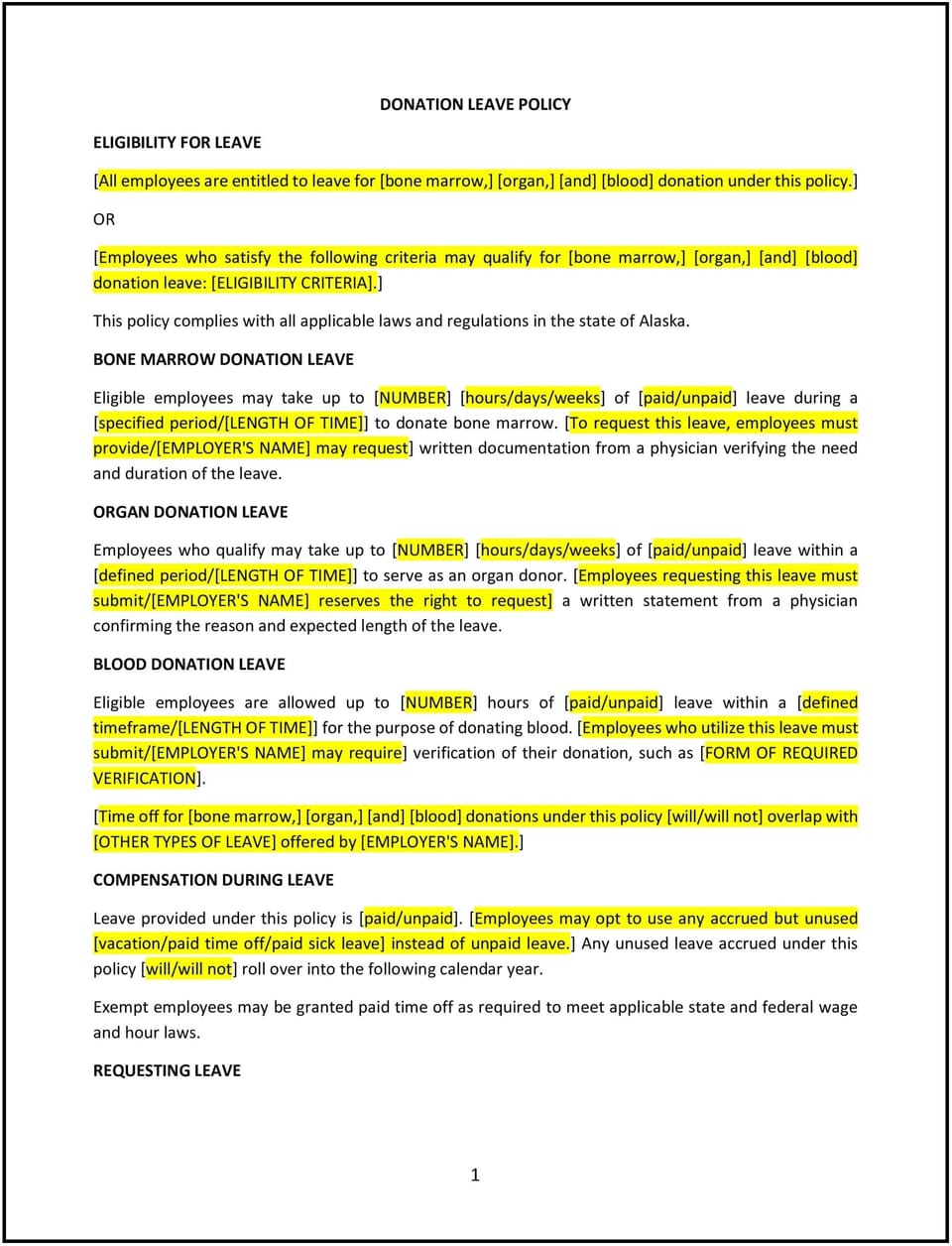Donation leave policy (Alaska): Free template

Donation leave policy (Alaska)
In Alaska, a donation leave policy provides employees with time off to participate in donation-related activities, such as blood or organ donation, without compromising their job security. This policy demonstrates a company’s commitment to social responsibility and employee well-being while fostering a culture of giving. By implementing this policy, businesses can encourage altruistic acts that benefit the community and support employees during their participation.
Alaska’s remote communities and unique challenges may require tailoring the policy to accommodate travel times, seasonal work schedules, or other logistical considerations for employees involved in donation activities.
How to use this donation leave policy (Alaska)
- Define eligible activities: Clearly specify the types of donation activities covered under the policy, such as blood drives, organ donation, or bone marrow registration.
- Establish leave duration: Outline the amount of leave provided for donation-related activities, such as hours for a blood drive or days for organ donation recovery.
- Include an approval process: Provide guidelines for requesting donation leave, including notice periods and any required documentation, such as proof of participation.
- Address compensation: Specify whether the leave is paid or unpaid and any conditions under which compensation applies.
- Communicate the policy: Ensure employees are informed about the policy during onboarding and through regular updates, encouraging awareness and participation.
Benefits of using a donation leave policy (Alaska)
A donation leave policy provides several benefits for businesses in Alaska. Here’s how it helps:
- Supports social responsibility: Encourages employees to engage in activities that benefit the broader community, enhancing the company’s public image.
- Enhances employee morale: Demonstrates the company’s commitment to supporting employees’ personal values and altruistic efforts.
- Promotes well-being: Allows employees to participate in life-saving or impactful activities without worrying about job security or penalties.
- Aligns with organizational values: Reinforces a culture of empathy and social contribution within the workplace.
- Encourages participation: Provides clear guidelines and incentives for employees to take part in donation-related activities.
Tips for using a donation leave policy (Alaska)
- Address logistical challenges: Consider providing additional support, such as flexible schedules or travel allowances, for employees in remote or rural areas.
- Partner with organizations: Collaborate with local blood banks, hospitals, or nonprofit organizations to promote donation opportunities within the community.
- Offer incentives: Recognize employees who participate in donation activities, such as through awards or company-wide acknowledgments.
- Monitor participation: Track the use of donation leave to assess its impact on employee engagement and community outreach efforts.
- Review periodically: Update the policy to reflect changes in local regulations, employee needs, or company priorities.
Q: How can I decide which donation activities to include in the policy?
A: Focus on activities that align with your company’s values and have a clear community impact, such as blood donation, organ donation, or bone marrow registration.
Q: How much leave should I provide for donation activities?
A: Determine leave durations based on the activity. For example, blood donation may require only a few hours, while organ donation recovery may necessitate several days. Align leave periods with operational needs and employee well-being.
Q: Should donation leave be paid or unpaid?
A: This depends on your business’s financial capacity and goals. Many companies offer paid leave for short-term activities like blood donation to encourage participation, while extended leave for organ donation may be unpaid or partially compensated.
Q: How can I manage employee absences during donation leave?
A: Plan ahead by cross-training team members or temporarily reallocating tasks to ensure continuity in operations during employee absences.
Q: How can I encourage employees to use this policy?
A: Promote the policy through internal communication, partner with local donation organizations, and recognize employees who participate to foster a culture of giving.
This article contains general legal information and does not contain legal advice. Cobrief is not a law firm or a substitute for an attorney or law firm. The law is complex and changes often. For legal advice, please ask a lawyer.


